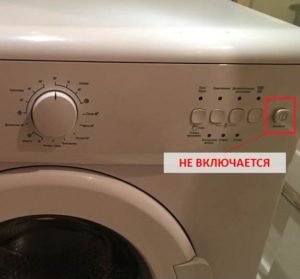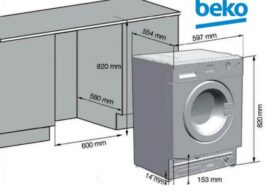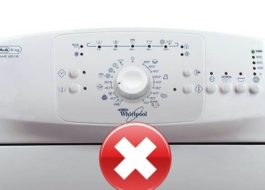Beko washing machine does not turn on
 It is unpleasant if the Beko washing machine does not turn on and the scheduled wash does not start. At the same time, outwardly everything is calm: the machine is plugged in, there is water, laundry is loaded into the drum, the door is closed and the powder is poured in. However, the LEDs on the dashboard do not light up, and the washing machine is “silent”, not responding to the user’s commands. In such a situation, there is no need to give up or refuse to wash. It is much more effective to put things aside, take them for diagnostics and identify the cause of the “inhibition”.
It is unpleasant if the Beko washing machine does not turn on and the scheduled wash does not start. At the same time, outwardly everything is calm: the machine is plugged in, there is water, laundry is loaded into the drum, the door is closed and the powder is poured in. However, the LEDs on the dashboard do not light up, and the washing machine is “silent”, not responding to the user’s commands. In such a situation, there is no need to give up or refuse to wash. It is much more effective to put things aside, take them for diagnostics and identify the cause of the “inhibition”.
What determines the behavior of the machine?
Even those far from repairing washing machines understand that panel lights that do not light up indicate a lost connection with the electrical network. Without current, the washing machine does not “wake up” and start working. It is logical that you will have to check the electrics and electronics - contact has been lost somewhere: inside the machine or outside it.
It’s better to start searching for the reason with the simplest and most banal:
- there are problems with power supply in the room;
- the socket to which the Beko is connected is de-energized or faulty;
- The power cord is damaged (the wire or plug is burnt out).
But sometimes electrical problems are not so obvious. Less noticeable breakdowns also occur:
- knocked out the noise filter (FPS);
- the “Start” button on the dashboard is stuck or burned out;
- The control board is broken.
If the Beko washing machine does not respond to being plugged into the mains, it means that the machine is cut off from the power supply.
The algorithm for what to do is extremely simple. It is necessary to sequentially check all possible “pain points” until the problem of failure is detected. First, we assess the condition of the supply lines, then we inspect the insides of the machine, and lastly, the Beko dashboard.
Check supply lines
If the washing machine does not start, then the first thing to do is check the power supply. As practice shows, most often the problem lies not in technology, but beyond it. Therefore, first we flip the switch indoors - perhaps there is no light in the house.
Afterwards we go to the counter and inspect the machines and traffic jams. It is possible that the network is damaged or that turning on the washing machine caused an overvoltage of the “branch”, the RCD tripped, and the power was automatically cut off. In this case, there is no malfunction; you just need to adjust the load on the wiring.
Next, we evaluate the performance of the outlet. Melted plastic, a burning smell or smoke are signs of burnt out contacts. If there is no visible damage, we connect to the electrical outlet with any working device. Everything is fine? So the problem is different.
The first signs of a short circuit are smoke, a burning smell, dark spots and melted plastic or insulation.
Having detected a problem or fire, it is necessary to eliminate it as soon as possible. But getting down to business without electrical engineering practice is strictly prohibited - it’s safer and more reliable to invite an experienced electrician. In any case, it is better to turn off the power to the apartment and not use electricity until the problem is resolved.
Electrical communications of the machine
If everything is in order with external power communications, then the failure occurred inside the machine. As a rule, the main “culprits” are the plug and wire of the power cord, the third in line is the interference filter. In any case, on Beko models, all three elements are inseparable, so they are all checked together.
We proceed like this:
- disconnect the machine from all communications, including the drain;
- we move the unit away from the wall, providing access to the rear wall;
- Unscrew the bolts holding the top cover;
- we find the network capacitor located in the lower left corner;
- loosen the fastening that secures the network cable;
- pull out the interference filter along with the cord and plug.

Elements are checked individually. First, the fork is inspected. The presence of melted plastic or dark spots on the insulation clearly indicates a fire has occurred. Then the cord is tested, which is “ringed” with a multimeter for breakdown. If the device detects a current leak, then it is prohibited to continue using the wire - replacement is necessary. In this case, local repairs are excluded, since experts do not recommend repairing a damaged core with electrical tape or twisting. Otherwise, there is a high probability of repeated breakage, short circuit and fire.
Before using the multimeter, you need to check its functionality: set the resistance mode and close the probes - the display should display “0”.
Next in line is FPS. The multimeter in ringing mode clings to the filter contacts, and if the result is positive, the resistance is also measured. When “0” or “1” is displayed, it will become clear that the capacitor is burnt out and needs to be replaced.
Look at the button
If the power cord and noise filter pass the test, then you will have to evaluate the condition of the dashboard. It is no secret that the Beko washing machine does not turn on if the Start/Pause button is stuck. The fact is that when the power button is closed, the entire washing machine is de-energized. With modern models, the probability of fatal sticking is low, and old machines, released 15-20 years ago, often “sin” like this.
It’s easy to confirm your guess with your own hands. You need to do the following:
- remove the powder receptacle;
- unscrew the bolts located around the perimeter of the dashboard;
- unhook the panel from the case (there is no need to unhook all the connected wiring - it is enough to provide free access to the board);
- Use a multimeter to measure the resistance of the start button.
When checking the dashboard, the resistance is measured with the buttons turned on.
As a rule, the frequently used “on-off” button burns out. But if it is intact, then you should measure the resistance on all keys, moving from the main ones to those rarely pressed. If there are no problems with the buttons, then the problem is with the control board. Diagnosing a module is a difficult matter, so it is better to entrust it to professionals.
Interesting:
Reader comments
- Share your opinion - leave a comment





















Add a comment